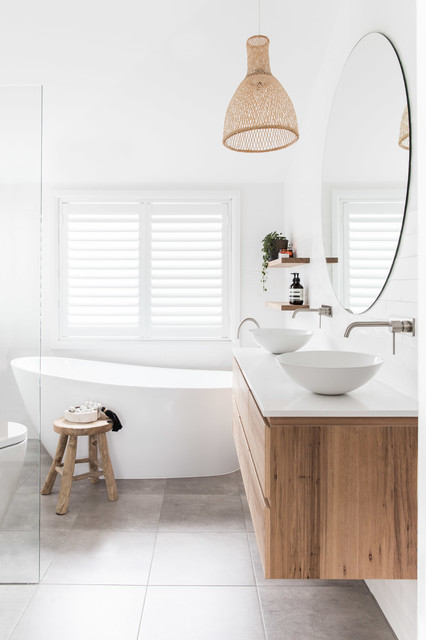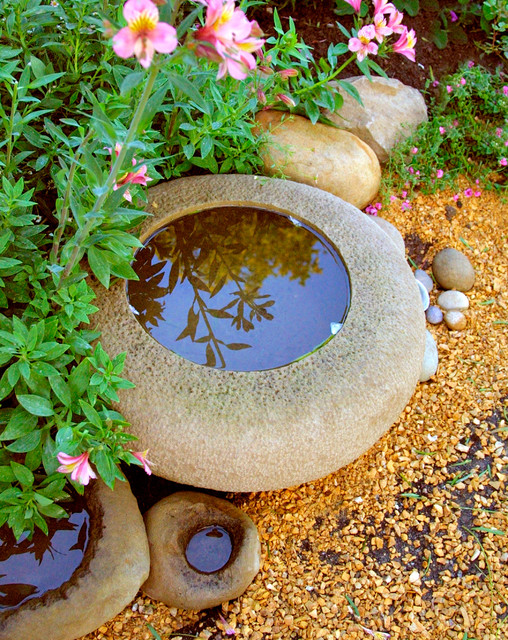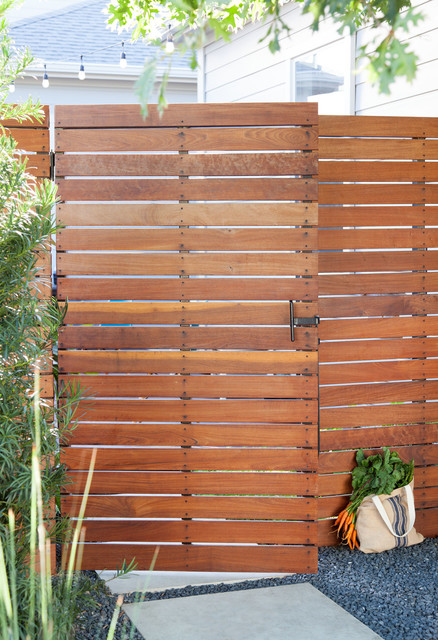Putting in a new bathroom isn’t cheap, so you’ll want to be sure that it delivers. Although that striking freestanding tub or statement tile may make your heart beat a little faster, it’s the layout that largely determines how well the space works. Houzz Australia asked four experts to share the layout mistakes they regularly see inexperienced bathroom renovators make — and how you can steer clear of them.
We also scoured Houzz photos for designs that successfully avoided these 10 missteps to achieve bathrooms that look great and function beautifully.
We also scoured Houzz photos for designs that successfully avoided these 10 missteps to achieve bathrooms that look great and function beautifully.
Need a pro for your bathroom remodeling project?
Let Houzz find the best pros for you
Let Houzz find the best pros for you
2. Having the Door Open to a View of the Toilet
Having the bathroom door open to directly face the toilet is neither stylish nor necessary, Cosway says.
Solution: “Tuck the loo behind the door or place it to the side where it’s not in full view when you open the bathroom door. Even more important, ensure that your main bathroom has a separate toilet so people do not have to wait for the loo when someone is using the shower,” she says.
If lines are forming outside your bathroom every morning, Cosway suggests upgrading your powder room so that family members can use it to get ready. You can do this by making sure it has an adequate sink, storage cabinetry and a mirror.
Tip: When planning the position of your toilet, allow at least 8 inches on both sides for elbow room, Cosway says.
Find a bathroom designer near you on Houzz
Having the bathroom door open to directly face the toilet is neither stylish nor necessary, Cosway says.
Solution: “Tuck the loo behind the door or place it to the side where it’s not in full view when you open the bathroom door. Even more important, ensure that your main bathroom has a separate toilet so people do not have to wait for the loo when someone is using the shower,” she says.
If lines are forming outside your bathroom every morning, Cosway suggests upgrading your powder room so that family members can use it to get ready. You can do this by making sure it has an adequate sink, storage cabinetry and a mirror.
Tip: When planning the position of your toilet, allow at least 8 inches on both sides for elbow room, Cosway says.
Find a bathroom designer near you on Houzz
3. Insufficient Storage
Focusing too much on aesthetics and not enough on function often leads to insufficient storage, Cosway says.
Solution: “Eye-level storage is critical in a bathroom. Rather than having a mirror adhered to the wall, choose a mirror cabinet recessed into the wall that incorporates storage for everyday essentials, such as your toothbrush, shaver and makeup,” she says.
Find recessed medicine cabinets in the Houzz Shop
Focusing too much on aesthetics and not enough on function often leads to insufficient storage, Cosway says.
Solution: “Eye-level storage is critical in a bathroom. Rather than having a mirror adhered to the wall, choose a mirror cabinet recessed into the wall that incorporates storage for everyday essentials, such as your toothbrush, shaver and makeup,” she says.
Find recessed medicine cabinets in the Houzz Shop
Here are some of Cosway’s key measurements for medicine cabinets and vanities.
Shop for toilets on Houzz
- A medicine cabinet above a vanity should be the same width as the vanity or slightly smaller — never larger.
- Recessing a medicine cabinet into the wall will give your bathroom a more streamlined look.
- The right length for a vanity countertop depends on the size of the room. For a family bathroom or en suite, 36 inches is considered a standard minimum length, but 48 inches is a little more practical.
- A double sink will need a countertop that’s at least 60 to 72 inches long.
- The ideal depth for a vanity is 21 inches, although it will depend on the depth of your sink.
- If you have a semirecessed sink, you may be able to make your vanity less than 21 inches deep.
- When specifying your vanity depth, make sure you include enough room so that you can clean the sink and faucets.
Shop for toilets on Houzz
4. Confining Storage to the Vanity
“Rookie renovators often don’t consider storage options beyond vanity drawers and cabinets,” says Maria Roussos, principal at interior design firm
Schemes & Spaces. “This often means the vanity ends up too clunky and dominating. As a result, the bathroom feels small and crowded.”
Solution: Roussos suggests thinking of alternative places to house bathing products, toiletries and toilet paper: “Can you work some custom [cabinetry] into the floor plan to store larger items? What about vertical wall-hung cabinets?” She points out that you also can use these to incorporate mirrors, lighting and towel bars, saving even more space in the bathroom and giving it a more purposeful feel.
“Rookie renovators often don’t consider storage options beyond vanity drawers and cabinets,” says Maria Roussos, principal at interior design firm
Schemes & Spaces. “This often means the vanity ends up too clunky and dominating. As a result, the bathroom feels small and crowded.”
Solution: Roussos suggests thinking of alternative places to house bathing products, toiletries and toilet paper: “Can you work some custom [cabinetry] into the floor plan to store larger items? What about vertical wall-hung cabinets?” She points out that you also can use these to incorporate mirrors, lighting and towel bars, saving even more space in the bathroom and giving it a more purposeful feel.
5. Poor Lighting
Roussos says inexperienced renovators often simply resort to downlights over the vanity, shower or toilet instead of putting in a proper layered lighting design. “As a result, the bathroom is often too bright and lacks ambiance, which makes it far from a relaxing space to spend time in,” she says. “Plus, the bright overhead lighting creates shadowing when you look in the vanity mirror —dreadful when you’re putting on makeup or shaving.”
Solution: Roussos suggests planning a layered design that includes several lighting sources. “It should feature lighting for ambiance; concealed LED strips are a great option, as they don’t consume much energy and can be left on to create a low-key mood. Put them under vanities and shaving cabinets, behind mirrors and in shower niches,” she says.
Roussos says inexperienced renovators often simply resort to downlights over the vanity, shower or toilet instead of putting in a proper layered lighting design. “As a result, the bathroom is often too bright and lacks ambiance, which makes it far from a relaxing space to spend time in,” she says. “Plus, the bright overhead lighting creates shadowing when you look in the vanity mirror —dreadful when you’re putting on makeup or shaving.”
Solution: Roussos suggests planning a layered design that includes several lighting sources. “It should feature lighting for ambiance; concealed LED strips are a great option, as they don’t consume much energy and can be left on to create a low-key mood. Put them under vanities and shaving cabinets, behind mirrors and in shower niches,” she says.
“Then add in lighting for other purposes,” Roussos says. “For example, incorporate task lighting to assist with grooming or putting on makeup, such as a pair of wall lights on either side of the mirror. These will illuminate your face from the front, which is the most effective and flattering direction.”
Tip: Ask your electrician to wire lights so that they can be turned on independently. This will let you adjust the lighting levels and mood, Roussos says.
Shop for all kinds of lighting
Tip: Ask your electrician to wire lights so that they can be turned on independently. This will let you adjust the lighting levels and mood, Roussos says.
Shop for all kinds of lighting
6. Not Creating Separate Zones
“When space is plentiful, I often see uninspiring and empty-looking bathrooms, with all the fixtures around the perimeter of the room and an empty space in the middle. Creating zones would have made these bathrooms far more functional and welcoming,” Roussos says.
Solution: Consider dividing a large bathroom into separate zones for the bath, shower, vanity and toilet. “This may be as simple as putting a stud wall into the center of the room,” she says. “Creating zones will enhance your experience of the bathroom and make it feel more luxurious.”
“When space is plentiful, I often see uninspiring and empty-looking bathrooms, with all the fixtures around the perimeter of the room and an empty space in the middle. Creating zones would have made these bathrooms far more functional and welcoming,” Roussos says.
Solution: Consider dividing a large bathroom into separate zones for the bath, shower, vanity and toilet. “This may be as simple as putting a stud wall into the center of the room,” she says. “Creating zones will enhance your experience of the bathroom and make it feel more luxurious.”
7. Not Considering Existing Infrastructure
“What’s behind the wall is a big deal when you’re renovating or changing a bathroom layout,” says Daniela Santilli, bathroom marketing leader for Reece, an Australian supplier of plumbing and bathroom products.
Solution: Make sure you work with your plumber to figure out if the new layout will work with current plumbing points and infrastructure,” she says. “You might need to rethink your layout if you don’t want to move these existing points. Remember, while changing plumbing points can give you the layout you really want, it can also blow out the budget.”
“What’s behind the wall is a big deal when you’re renovating or changing a bathroom layout,” says Daniela Santilli, bathroom marketing leader for Reece, an Australian supplier of plumbing and bathroom products.
Solution: Make sure you work with your plumber to figure out if the new layout will work with current plumbing points and infrastructure,” she says. “You might need to rethink your layout if you don’t want to move these existing points. Remember, while changing plumbing points can give you the layout you really want, it can also blow out the budget.”
8. Measuring Incorrectly
Santilli warns that inaccurate measurements can end up being costly when you need to work multiple elements into your layout. “It’s a common mistake not to take account of the little things, such as the way a door will swing or the gap between the toilet and the vanity,” she says.
Solution: “Always measure twice before you select fittings and fixtures for your bathroom to make sure they’ll fit. Think how doors and drawers will open and how you will move through the space. Your builder, plumber or project manager should also be able to help you with this process,” Santilli says.
Santilli warns that inaccurate measurements can end up being costly when you need to work multiple elements into your layout. “It’s a common mistake not to take account of the little things, such as the way a door will swing or the gap between the toilet and the vanity,” she says.
Solution: “Always measure twice before you select fittings and fixtures for your bathroom to make sure they’ll fit. Think how doors and drawers will open and how you will move through the space. Your builder, plumber or project manager should also be able to help you with this process,” Santilli says.
9. Storage That Lacks Function
Jenefer Gordon, principal at interior design firm Eat Bathe Live, says failing to consider exactly how you use your bathroom means that the items you keep there often don’t have a proper home. “They end up being left out on the vanity, creating a cluttered look, or stored far from where you actually use them,” she says.
Solution: Consider how you use the bathroom and exactly which items need to be stored there, and then measure them and give them a dedicated spot, Gordon says. “For example, electric toothbrushes and shavers can be stored in a recessed mirrored cabinet with power inside, shallow drawers with dividers are great for makeup, and towels and standing toiletries can be placed in deep drawers,” she says.
Jenefer Gordon, principal at interior design firm Eat Bathe Live, says failing to consider exactly how you use your bathroom means that the items you keep there often don’t have a proper home. “They end up being left out on the vanity, creating a cluttered look, or stored far from where you actually use them,” she says.
Solution: Consider how you use the bathroom and exactly which items need to be stored there, and then measure them and give them a dedicated spot, Gordon says. “For example, electric toothbrushes and shavers can be stored in a recessed mirrored cabinet with power inside, shallow drawers with dividers are great for makeup, and towels and standing toiletries can be placed in deep drawers,” she says.
10. Not Considering the Location of Accessories
Not giving enough thought to the location of accessories, such as towel bars and shower storage, will affect how the whole space functions, Gordon says. “It can mean frequently used items have to be positioned out of reach, or wall-mounted accessories end up in the way of drawers or cabinetry doors.
“You also need to plan where accessories will go, so you can install enough secure fixing points,” she says. After all, nobody wants to have a wobbly towel bar or the toilet paper holder to fall off the wall — “which is what can happen when they’ve only been screwed into a plaster sheet,” she says.
Not giving enough thought to the location of accessories, such as towel bars and shower storage, will affect how the whole space functions, Gordon says. “It can mean frequently used items have to be positioned out of reach, or wall-mounted accessories end up in the way of drawers or cabinetry doors.
“You also need to plan where accessories will go, so you can install enough secure fixing points,” she says. After all, nobody wants to have a wobbly towel bar or the toilet paper holder to fall off the wall — “which is what can happen when they’ve only been screwed into a plaster sheet,” she says.
Solution: “Think how you’ll use and move through the space when planning where to position accessories on your bathroom layout,” Gordon says. Put towel bars within easy reach of the shower, bath and vanity. Put hand towel bars where they won’t prevent vanity drawers and doors from opening.
Also ensure that structural supports are in place before the walls are finished so that accessories have something to attach to, she says.
Also ensure that structural supports are in place before the walls are finished so that accessories have something to attach to, she says.
Tip: Consider a recessed tiled niche in the shower instead of a shelf affixed to the wall to give the area a more open feel, Gordon says.
Source: Houzz
To see the original article: https://www.houzz.com/magazine/10-bathroom-layout-mistakes-and-how-to-avoid-them-stsetivw-vs~116563168























“Too often I see [60-inch-long] freestanding baths in rooms that are only [70 inches] in length,” says Frances Cosway, an interior designer and principal at White Pebble Interiors, and the author of Your Forever Home. “These bathtubs are simply too big for the space. I also see vanities and showers that are the wrong scale.”
Solution: “Ensure that the bath, vanity and shower are the right scale for your bathroom,” she says. If you are specifying a freestanding tub, make sure there is space around it for cleaning.
“Freestanding baths, while fashionable, are not always the best option — particularly in a small bathroom,” Cosway says. “A [60-inch] freestanding bath is very small, and if this is your only option, a larger inset bath would be a much better use of space.
“Likewise with vanities — having a super large vanity that butts right up to the shower does not look good and is awkward to clean. Instead, choose a smaller vanity and allow some space between the shower or bath,” she says.
Tip: A freestanding tub should be about 8 inches from the wall, with at least a foot of space at both ends to allow for cleaning access, Cosway says.